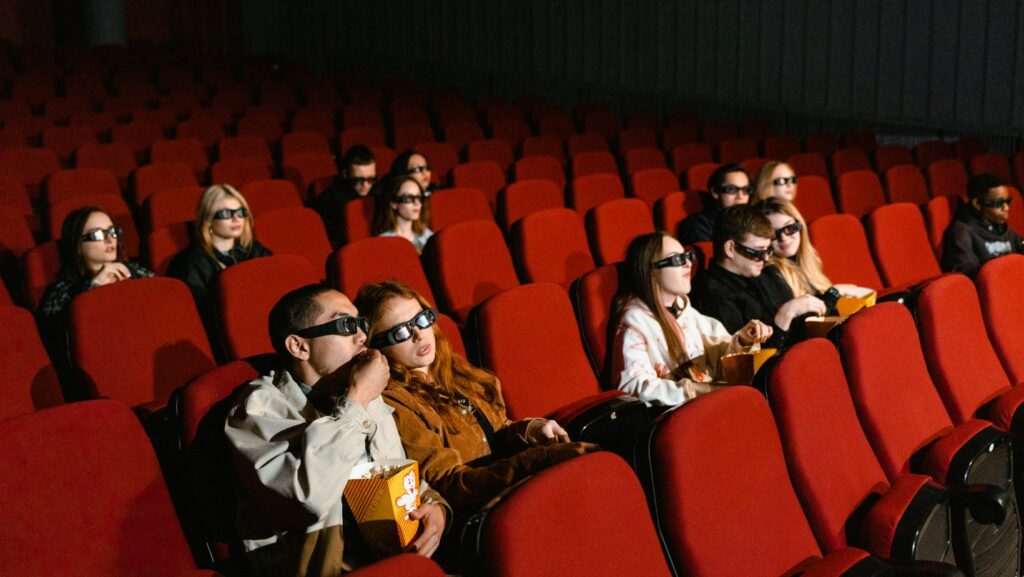Key Takeaways
- Evolving Cinema Landscape: Cinema is continuously changing, influenced by societal shifts, technological advancements, and audience preferences, ensuring an exciting environment for filmmakers and viewers alike.
- Rise of Streaming Platforms: Streaming services have transformed film consumption, offering accessibility and diverse original content that cater to a wide range of audience tastes.
- Focus on Diverse Storytelling: There is a growing demand for authentic narratives that represent underrepresented groups, leading to innovative storytelling and a broader exploration of genres.
- Growth of Independent Films: The streaming revolution has provided independent films with greater visibility and creative freedom, allowing for unique voices and perspectives in cinema.
- Technological Innovations: Advancements like virtual reality and high-definition formats are reshaping how films are produced and experienced, enhancing viewer engagement and storytelling depth.
- Environmental Sustainability: The film industry is increasingly focusing on eco-friendly practices, recognizing the importance of sustainability in production processes and audience expectations.
Cinema is constantly evolving, reflecting changes in society, technology, and audience preferences. As filmmakers explore new narratives and innovative techniques, the landscape of film continues to shift, making it an exciting time for both creators and viewers. From the rise of streaming platforms to the resurgence of diverse storytelling, these trends shape the way stories are told on screen. In recent years, audiences have shown a growing appetite for authenticity and representation, pushing filmmakers to break traditional molds. As blockbuster franchises dominate the box office, indie films are carving out their own space, showcasing unique voices and perspectives. Understanding these trends not only enhances the viewing experience but also highlights the dynamic nature of the film industry.
Trends in Cinema
 Cinema continues to evolve, reflecting societal changes and technological advancements. Streaming platforms gained dominance, serving diverse audiences and shifting viewing habits. Filmmakers now explore innovative narratives and techniques that cater to these evolving preferences.
Cinema continues to evolve, reflecting societal changes and technological advancements. Streaming platforms gained dominance, serving diverse audiences and shifting viewing habits. Filmmakers now explore innovative narratives and techniques that cater to these evolving preferences.
Rise of Streaming Platforms
Streaming platforms like Netflix, Amazon Prime, and Disney+ transformed how audiences consume films. These services offer:
- Accessibility: Viewers access extensive catalogs anytime and anywhere.
- Diverse Content: An array of genres and styles attracts various demographics.
- Original Productions: Platforms invest in exclusive content, allowing unique storytelling.
Demand for Diverse Storytelling
Audiences increasingly seek stories that resonate with their experiences. This demand leads filmmakers to:
- Highlight Underrepresented Groups: Films showcase perspectives from diverse cultures and communities.
- Explore Varied Genres: Innovative storytelling breaks traditional genre boundaries, engaging broader audiences.
- Foster Authentic Narratives: Real-life experiences and culturally relevant themes attract viewer interest.
Growth of Independent Films
The rise of streaming platforms creates space for independent films, which offer:
- Creative Freedom: Indie films experiment with narrative styles and techniques without commercial constraints.
- Fresh Perspectives: Unique stories emerge, often telling experiences outside mainstream cinema.
- Enhanced Distribution: Digital platforms ease distribution, increasing visibility for independent projects.
Advances in Technology
Technological innovations significantly impact filmmaking and viewing experiences. Current trends include:
- Virtual Reality (VR): VR experiences immerse viewers, creating new narrative possibilities.
- High-Definition Formats: Technologies like 4K and IMAX enhance visual storytelling.
- Artificial Intelligence (AI): AI streamlines production processes, optimizing everything from scriptwriting to post-production.
Increased Focus on Authenticity and Representation
Audiences prioritize authenticity in film content, prompting filmmakers to:
- Prioritize Casting: Authentic representation in casting aligns with psychological and cultural accuracy.
- Utilize Diverse Crew Members: A varied production team enhances storytelling depth.
- Encourage Representation: Films that reflect societal diversity resonate strongly with viewers.
The film industry remains dynamic, driven by technological advances and changing audience preferences. These trends highlight the need for continual adaptation in storytelling and production practices, ensuring cinema’s relevance in modern entertainment.
Technological Advancements
Technological advancements significantly shape the film industry, enhancing production techniques and altering how audiences consume content.
Streaming Services Revolution
Streaming services transformed film consumption by facilitating instant access to diverse content libraries. Platforms like Netflix, Amazon Prime, and Disney+ lead this change, offering original films and series that challenge traditional distribution methods. Subscribers increased to over 1.1 billion globally by 2023, underscoring the demand for accessible entertainment. The direct-to-consumer model enables filmmakers to reach larger audiences without relying solely on theatrical releases. Innovations in algorithm-based recommendations further personalize viewer experiences, increasing engagement and satisfaction.
Virtual Reality Experiences
Virtual reality (VR) experiences offer immersive storytelling opportunities. Filmmakers utilize VR technology to create interactive narratives, allowing audiences to engage with the story actively. According to a 2022 industry report, investment in VR cinema projects rose by 30% from the previous year, signaling growing interest. VR enhances emotional connections, providing viewers with unique perspectives while exploring environments and characters. This technology pushes the boundaries of traditional filmmaking, appealing to tech-savvy audiences seeking novel experiences.
Changes in Storytelling
Cinema increasingly reflects diverse perspectives and interactive formats, shaping modern narratives and audience engagement.
Diverse Narratives
Diverse narratives gain prominence as filmmakers focus on representing underrepresented groups. This trend highlights cultural authenticity and explores unique life experiences, enriching storylines. Examples of films such as “”Parasite”” and “”Black Panther”” showcase the appeal of stories that reflect varied backgrounds and experiences, generating dialogue around essential social issues. According to a 2022 study by the USC Annenberg Inclusion Initiative, films featuring diverse casts and crews perform better financially, indicating audience demand for inclusive storytelling. As a result, studios prioritize collaboration with diverse writers, directors, and actors to foster authenticity and relevance within their projects.
Interactive Storytelling
Interactive storytelling emerges as a transformative element in cinema, allowing audiences to influence narratives. Platforms like Netflix and specific titles such as “”Black Mirror: Bandersnatch”” exemplify this trend, enabling viewers to make choices that affect character outcomes. This engagement cultivates a deeper emotional connection and enhances viewer investment in the story. The rise of virtual reality (VR) further expands interactive possibilities, offering immersive experiences where audiences can navigate and explore narratives. Industry experts predict that this trend will continue to evolve, as advancements in technology create innovative storytelling opportunities that redefine audience participation.
Audience Engagement
Audience engagement in cinema is undergoing a significant transformation, particularly driven by technological advancements and changing viewer preferences. Filmmakers and studios are strategizing to connect more deeply with diverse audiences.
Social Media Influence
Social media platforms play a crucial role in shaping audience interaction with cinema. Instant communication and user-generated content allow fans to engage with films before, during, and after their release. Platforms like Twitter and Instagram enable viral marketing campaigns, strengthening viewer anticipation. Influencers share opinions and reviews, directly impacting box office performance and streaming viewership. A report by the Pew Research Center highlights that 72% of adults use social media, making it a powerful tool for filmmakers to reach wider demographics and foster community discussions around films. Hashtags and challenges related to movies enhance visibility, encouraging audience participation and feedback.
and user-generated content allow fans to engage with films before, during, and after their release. Platforms like Twitter and Instagram enable viral marketing campaigns, strengthening viewer anticipation. Influencers share opinions and reviews, directly impacting box office performance and streaming viewership. A report by the Pew Research Center highlights that 72% of adults use social media, making it a powerful tool for filmmakers to reach wider demographics and foster community discussions around films. Hashtags and challenges related to movies enhance visibility, encouraging audience participation and feedback.
Global Viewership Expansion
Global viewership for films is expanding rapidly, driven by the accessibility of streaming services. Films like “”Squid Game”” and “”The Irishman”” gained international acclaim, showcasing the widespread appeal of diverse narratives. According to a report by PwC, global box office revenue saw a 23% increase from $12 billion in 2021 to $14.8 billion in 2022, reflecting the growing interest in cinema worldwide. The proliferation of subtitles and dubbing allows productions from various countries to appeal to broader audiences, fostering cultural exchange. Additionally, international co-productions are on the rise, enabling filmmakers to share unique stories that resonate across different regions, thus enhancing the global cinematic landscape.
Environmental Sustainability in Film
Environmental sustainability is increasingly significant in the film industry, as filmmakers recognize the environmental impact of production processes. Efforts focus on reducing carbon footprints and promoting eco-friendly practices. The adoption of green production guidelines by various organizations encourages filmmakers to implement sustainable strategies in their projects.
- Eco-friendly Practices: Filmmakers adopt eco-friendly practices, such as using solar panels for energy and prioritizing resource recycling during production. These strategies minimize waste and reduce energy consumption.
- Sustainable Locations: Many productions scout for sustainable filming locations. By choosing environmentally conscious settings, filmmakers can minimize transportation emissions and contribute to local economies.
- Digital Technologies: Digital filmmaking techniques reduce the need for physical materials. Utilizing CGI and digital sets can lessen the environmental impact caused by traditional sets and props, leading to sustainable visual storytelling.
- Community Engagement: Filmmakers engage local communities in sustainability initiatives. Collaborations with local organizations promote awareness and foster a sense of shared responsibility for environmental stewardship.
- Documentary Influence: Documentaries highlighting environmental issues raise awareness and inspire change. Films such as “”Chasing Ice”” and “”Our Planet”” emphasize the urgency of sustainability, compelling audiences to consider their environmental impact.
According to the Green Production Guide, adopting sustainable practices not only benefits the environment but also enhances a project’s marketability. Audiences increasingly support productions committed to social and environmental responsibility, making sustainability a viable aspect of modern filmmaking. The landscape of cinema is rapidly evolving as it adapts to the demands of modern audiences. Filmmakers are embracing diversity and authenticity while leveraging technology to enhance storytelling. The rise of streaming platforms has not only transformed how films are consumed but also expanded the reach of unique narratives.
Interactive storytelling and immersive experiences are reshaping audience engagement, allowing viewers to become part of the narrative. Additionally, a commitment to sustainability is becoming integral to production practices, reflecting a growing awareness of environmental impact. As the film industry continues to innovate and respond to societal changes, it remains poised to captivate and inspire audiences worldwide.



